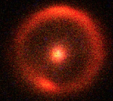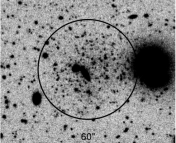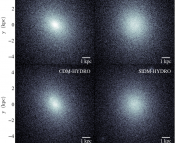Title: Probing dark matter substructure in the gravitational lens HE0435-1223 with the WFC3 grism
Authors: A. M. Nierenberg, T. Treu, G. Brammer, A. H. G. Peter, C. D. Fassnacht, C. R. Keeton, C. S. Kochanek, K. B. Schmidt, D. Sluse, S. A. Wright
First Author’s Institution: Center for Cosmology and AstroParticle Physics, The Ohio State University, Columbus, OH
Status: Submitted to MNRAS, [open access]
Our best model of our universe, Lambda cold dark matter (LCDM for short) predicts that the universe should be bristling with little galaxies. Milky Way, for instance, should be surrounded by hundreds of galaxies at least a thousand times less massive than itself. But we’ve seen only a perplexing few tens of small galaxies around our home galaxy, a conundrum that’s been given its own name, the missing satellites problem. It turns out that dwarf galaxies—those at least a thousand times less massive than the Milky Way—are finicky when it comes to producing stars, as they don’t have much star-forming gas to work with. If you lined up a series of small galaxies identical in mass, you’d find that some teem with stars, shining like beacons in the dark, while others have but a handful, preferring to be veiled in murky darkness. And to make matters more complicated, the least massive galaxies tend to fizzle more often than flare. There may be legions of small, dark galaxies hiding in the universe.
This may make the task of finding the missing satellites seem like a lost cause. But it’s yet possible for us to detect them. As small as these dim galaxies may be, by virtue of possessing mass, they can bend and focus light from a bright object into a brilliant beam—a process we call gravitational lensing. Given that they aren’t very massive, this isn’t a strong effect. But when they’re near a larger galaxy, their beams can amplify. The authors of today’s paper—whizzes in the art of little galaxy hunting—meted out a procedure to do this with an optical spectrograph aboard Hubble Space Telescope (HST). They tackled one type of lens system in particular: large galaxies—likely host to many dwarfs—which have lensed a particular bright object called a quasar behind it into four mirror images (thus their nickname, “quad quasars”; you can understand how they form with a wineglass!). The ratios of the fluxes between each of the quasar images are well known—should a dwarf galaxy exist near any of the quasar images, boosting the flux of one or more of the image(s), it could be detected by looking for unusual ratios between the fluxes of the quasar images.
What was unusual about their method was that they did not use the total flux from each quasar image. The optical light from a quasar can undergo large variations due to lensing by stars within the large, lens galaxy. The variation acts much like how a large, bustling city wouldn’t get perceptibly brighter at night when you turn on your car’s headlights, whereas the small patch of road in front of you does. The optical portion of the quasar is about the size of the star-lensed beams, and can thus can significantly change the flux—in order to be free of stellar microlensing, one must look at the emission from a much larger region of the quasar. Thus the authors turned instead to the flux from a bright emission line produced by highly ionized oxygen in the comparatively large, hot regions within quasars, the [O III] line. They carefully modeled the line, accounting for contributions from the lens galaxy and surrounding bright objects, as well as other line contaminants to derive [O III] fluxes for each quasar image.

Figure 1. Modeling of the quad quasar studied in today’s paper. The quad quasar studied by the authors of today’s paper is shown in the black and white image at the top left. The four quasar images are those labeled A, B, C, and D, while the lens galaxy is labeled G; an additional galaxy close by is noted by G2. Their optical spectra is shown in the middle left panel (ii). A simulated image is shown in color at the bottom, with the colors denoting the different bright objects they modeled: the quasar images (blue), the two galaxies G and G2 (green), and a lensed ring (red). The spectra they simulated of each of these objects is shown on the right. Figure taken from today’s paper.
The authors applied their new method to a particular quad quasar that had been studied before, HE0435-1223. They found that the [O III] flux ratios were well behaved—the lens galaxy could explain the four image fluxes, no dwarf galaxy needed. In fact, the flux ratios were so pristine that they ruled out a perturbing dwarf for large swaths of the lens galaxy. This isn’t too surprising. The authors estimate that in a LCDM universe, there’s at best a 30% chance that each quasar image would be perturbed by a galaxy of ~108 solar masses.
It may be disappointing that no dwarf galaxy was found hidden within HE0435-1223, but the new method has opened the door for many more dwarf galaxy searches in quad quasars. Optical quad quasars will soon be in plentiful supply: more HST quad quasars are on their way, and up and coming surveys such as with the Large Synoptic Survey Telescope and the Dark Energy Survey, will dramatically increase the number of known quad quasars. We’ll soon be able to discover whether the satellites really are missing—calling for a revision of LCDM—or if they’ve just been lurking out of view all along.





Trackbacks/Pingbacks